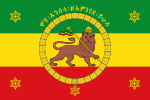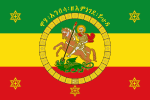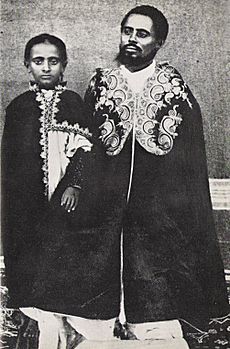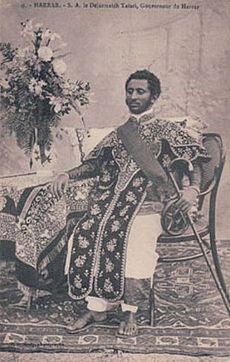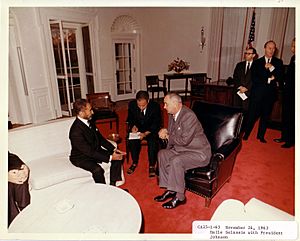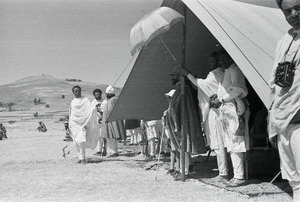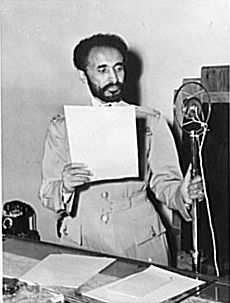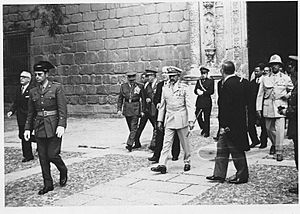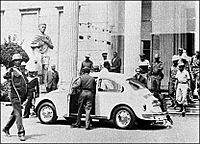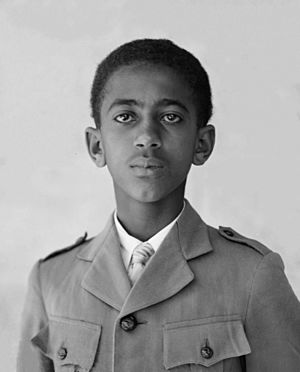Haile Selassie facts for kids
Quick facts for kids Haile Selassie Iቀዳማዊ ኀይለ ሥላሴ |
|||||
|---|---|---|---|---|---|
| Negusa Nagast | |||||
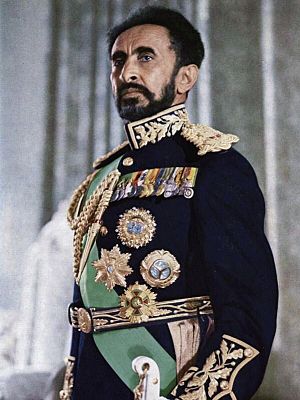
Haile Selassie in dress uniform, 1970
|
|||||
| Emperor of Ethiopia | |||||
| Reign | 2 April 1930 – 2 May 1936 20 January 1941 – 12 September 1974 |
||||
| Coronation | 2 November 1930 | ||||
| Predecessor | Zewditu | ||||
| Successor | Amha Selassie | ||||
| Prime Minister |
Himself
Wolde Tzaddick Makonnen Endelkachew Abebe Aregai Imru Haile Selassie Aklilu Habte-Wold Endelkachew Makonnen Mikael Imru |
||||
| Regent Plenipotentiary of Ethiopia | |||||
| Reign | 27 September 1916 – 2 April 1930 | ||||
| Predecessor | Tessema Nadew | ||||
| Successor | Ijigayehu Amha Selassie | ||||
| Monarch | Zewditu | ||||
| Born | Tafari Makonnen 23 July 1892 Ejersa Goro, Hararghe, Ethiopian Empire |
||||
| Died | 27 August 1975 (aged 83) National Palace, Addis Ababa, Ethiopia |
||||
| Burial | 5 November 2000 Holy Trinity Cathedral, Addis Ababa, Ethiopia |
||||
| Spouse | Menen Asfaw | ||||
| Issue |
|
||||
|
|||||
| Dynasty | House of Solomon (Shewan branch) | ||||
| Father | Makonnen Wolde Mikael | ||||
| Mother | Yeshimebet Ali | ||||
| Religion | Ethiopian Orthodox Tewahedo | ||||
| Signature | |||||
| 1st and 5th Chairperson of the Organisation of African Unity | |||||
| In office 25 May 1963 – 17 July 1964 |
|||||
| Succeeded by | Gamal Abdel Nasser | ||||
| In office 5 November 1966 – 11 September 1967 |
|||||
| Preceded by | Joseph Arthur Ankrah | ||||
| Succeeded by | Joseph-Désiré Mobutu | ||||
Haile Selassie I (born Tafari Makonnen; 23 July 1892 – 27 August 1975) was the last Emperor of Ethiopia. He ruled from 1930 to 1974. He became a powerful leader as the Regent of Ethiopia for Empress Zewditu starting in 1916.
Haile Selassie is seen as a very important person in modern Ethiopian history. He is also a key figure for the Rastafari religious movement in Jamaica. This movement began shortly after he became emperor in the 1930s. He was part of the Solomonic dynasty, a royal family that believed they were related to Menelik I. Menelik I was thought to be the son of King Solomon and Makeda, the Queen of Sheba.
Haile Selassie tried to make Ethiopia more modern. He brought in the country's first written constitution in 1931. He also worked to end slavery. He tried to defend Ethiopia during the Second Italo-Ethiopian War but was unsuccessful. He spent much of the time Italy occupied Ethiopia living in England. He returned to Ethiopia in 1941 after the East African campaign. He later ended the federation of Ethiopia and Eritrea. He made Eritrea a province of Ethiopia, even though there was fighting to prevent it from breaking away.
Haile Selassie believed in international cooperation. This led to Ethiopia becoming a founding member of the United Nations. In 1963, he helped create the Organisation of African Unity. This group was a first step toward the African Union. He was also its first chairman. In 1974, a military group called the Derg took over the government. Haile Selassie was killed on 27 August 1975.
Some followers of the Rastafari movement believe Haile Selassie is like a returned messiah from the Bible. They see him as God in human form. However, Haile Selassie was a Christian. He followed the beliefs of the Ethiopian Orthodox Church. The Rastafari movement started in Jamaica around 1930. By 2012, about 700,000 to one million people were followers.
Some historians have criticized Haile Selassie. They say he stopped rebellions by powerful nobles who did not like his reforms. Some also say Ethiopia did not modernize fast enough under his rule. His government was also criticized by human rights groups. They called it autocratic, meaning one person had all the power.
Contents
- Who Was Haile Selassie?
- Early Life and Rise to Power
- Becoming King and Emperor
- War with Italy
- Return to Power and Modernization Efforts
- Challenges in the 1960s
- Later Years and Overthrow
- Haile Selassie's Family
- Haile Selassie and the Rastafari Movement
- Titles and Achievements
- Images for kids
- See also
Who Was Haile Selassie?
| Styles of Haile Selassie I of Ethiopia |
|
|---|---|
 |
|
| Reference style |
|
| Spoken style |
|
| Alternative style |
|
As a child, Haile Selassie was known as Lij Tafari Makonnen. Lij means "child" and showed that he was from a noble family. His first name, Tafari, means "one who is respected or feared." Like most Ethiopians, his name was followed by his father's name, Makonnen Wolde Mikael, and his grandfather's name. He received the name Haile Selassie when he was baptized as a baby. He used it again as his royal name in 1930.
On 1 November 1905, when he was 13, Tafari became the Dejazmatch of Gara Mulatta. This title was like a Count. On 27 September 1916, he was named Crown Prince. He also became the Regent Plenipotentiary, which meant he had full power to rule. On 11 February 1917, he was crowned Le'ul-Ras. Ras means "head" and is a title like a Duke.
On 2 November 1930, after Empress Zewditu died, Tafari became Negusa Nagast. This means "King of Kings" and is translated as "Emperor." When he became emperor, he chose the name Haile Selassie I. Haile means "Power of" and Selassie means trinity. So, Haile Selassie means "Power of the Trinity."
His full title was "By the Conquering Lion of the Tribe of Judah, His Imperial Majesty Haile Selassie I, King of Kings, Lord of Lords, Elect of God." This title shows the Ethiopian belief that their rulers came from Menelik I. Menelik I was believed to be the son of King Solomon and the Queen of Sheba.
Ethiopians knew Haile Selassie by many names, like Janhoy and Abba Tekel. The Rastafari movement also uses names like Jah and Jah Rastafari for him.
Early Life and Rise to Power
Haile Selassie was born on 23 July 1892, in Ejersa Goro, Ethiopia. His royal family line came from the Solomonic King, Sahle Selassie. His mother was Woizero Yeshimebet Ali, from a ruling family. His father was Ras Makonnen Wolde Mikael. He was a general in the First Italo–Ethiopian War. Haile Selassie was related to Emperor Menelik II through his grandmother. This connection allowed him to become emperor.
His father made sure Tafari and his cousin, Imru Haile Selassie, received a good education. Tafari became Dejazmach (like a count) at age 13. His father died shortly after, in 1906.
Becoming a Governor
In 1906, Tafari became the governor of Selale. In 1907, he became governor of part of Sidamo. It is believed that in his late teens, Haile Selassie married Woizero Altayech. They had a daughter named Princess Romanework.
After his brother Yelma died in 1907, Tafari became governor of Harar around 1910 or 1911. On 3 August 1911, he married Menen Asfaw.
Taking on the Role of Regent
Tafari Makonnen played a big part in removing Lij Iyasu from power. Iyasu was supposed to be emperor from 1913 to 1916. But he was known for bad behavior and disrespecting nobles. He also showed interest in Islam, which was seen as treason by the Christian leaders. On 27 September 1916, Iyasu was removed from power.
Tafari was chosen because he had support from both modern and traditional groups. Empress Zewditu, Menelik II's daughter, became empress. Tafari became Ras and the Crown Prince. He also became the Regent Plenipotentiary. This meant he was the real ruler of Ethiopia. Zewditu would be the empress, and Tafari would manage the country.
On 11 February 1917, Zewditu was crowned. She promised to rule fairly through Tafari. Tafari worked to modernize Ethiopia, continuing what Menelik II had started. He also survived the 1918 flu pandemic. In 1923, he helped Ethiopia join the League of Nations. He promised to end slavery, a practice that still existed in Ethiopia.
Traveling the World
In 1924, Ras Tafari traveled to Europe and the Middle East. He visited places like Jerusalem, Paris, London, and Geneva. His main goal was for Ethiopia to get access to the sea. He also visited schools, hospitals, and factories. Tafari was careful about European influence. He wanted all businesses in Ethiopia to have some local ownership. He said, "We need European progress only because we are surrounded by it."
People were very interested in Tafari and his group during their travels. They brought lions as gifts for leaders like King George V of the United Kingdom. In return, the United Kingdom gave Tafari the imperial crown of Emperor Tewodros II. This crown had been taken during a British expedition in 1868.
While in Jerusalem, Tafari adopted 40 Armenian orphans. Their parents had died during the Armenian Genocide. Tafari arranged for them to learn music. They later formed the imperial brass band.
Becoming King and Emperor
In 1928, Tafari's power was challenged by Dejazmach Balcha Safo. Balcha Safo was a governor who was not sending enough money to the government. Tafari removed him from his position.
Some people in the palace tried to remove Tafari from power in September 1928. But Tafari had more support from the public and the police. On 7 October 1928, Empress Zewditu crowned Tafari as Negus (King).
Having two monarchs in the same place was unusual. This led to a rebellion by Ras Gugsa Welle, the empress's husband. On 31 March 1930, Gugsa Welle was defeated and killed in battle. Empress Zewditu died suddenly on 2 April 1930. It was later found she died from illness.

After Zewditu's death, Tafari became emperor. He was crowned on 2 November 1930, at Addis Ababa's Cathedral of St. George. The coronation was a grand event. Royals and important people from around the world attended. This included Prince Henry, Duke of Gloucester from the UK.
Haile Selassie introduced Ethiopia's first written constitution on 16 July 1931. This constitution created a two-house parliament. It kept power with the nobles but also set up steps for future democratic rule. The constitution said that only Haile Selassie's family could inherit the throne.
In 1932, the Sultanate of Jimma became part of Ethiopia.
War with Italy
In the 1930s, Benito Mussolini's Fascist government in Italy wanted to conquer Ethiopia. Italy wanted revenge for past military defeats. They also wanted to connect their colonies in Eritrea and Somaliland. Ethiopia was a member of the League of Nations, but this did not stop Italy from invading in 1935. The League of Nations did not effectively help Ethiopia.
Fighting the Invasion
After Italy invaded in December 1934, Haile Selassie joined his armies in the north. Italy had a very modern military with a large air force. They used chemical weapons during the conflict. They even attacked Red Cross hospitals, which was against international rules.
In October 1935, the Italians invaded. Haile Selassie's armies fought back in what was called the "Christmas Offensive." But in early 1936, the Italians pushed back. Haile Selassie led the last Ethiopian army on the northern front. On 31 March 1936, his army was defeated at the Battle of Maychew. As his army retreated, the Italians attacked from the air.
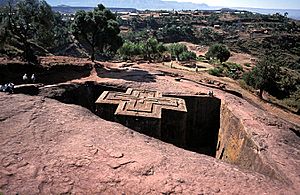
Haile Selassie visited the churches at Lalibela before returning to his capital. The government decided that Addis Ababa could not be defended. They decided to move the government to Gore. They also decided that the emperor's wife, Menen Asfaw, and the royal family should go to Jerusalem for safety.
Life in Exile
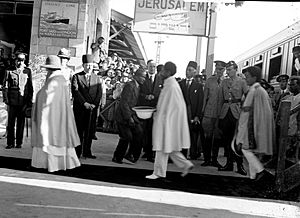
Haile Selassie decided to leave Ethiopia with his family. He wanted to present Ethiopia's case to the League of Nations in Geneva. He appointed his cousin Ras Imru Haile Selassie as Regent. On 2 May 1936, he left for French Somaliland.
On 5 May, Italian troops entered Addis Ababa. Mussolini declared Ethiopia an Italian province. Haile Selassie and his family traveled to Jerusalem. From there, they went to Geneva.
At the League of Nations, Haile Selassie gave a powerful speech. He spoke in his native Amharic. He said that his people were being killed because his "confidence in the League was absolute." He pointed out that European countries were not helping Ethiopia, but were helping Italy. He warned that the aggression threatened all small countries. His speech made him a symbol for people against fascism around the world. However, the League only put partial sanctions on Italy, which were not effective.
Haile Selassie lived in Bath, England, from 1936 to 1941. He bought a house called Fairfield House. He spent his time writing his life story. He also worked to tell the world about the Italian occupation. He spoke out against the destruction of churches and historical items. He also condemned the terrible things happening to Ethiopian civilians. His efforts to get support were not very successful until Italy joined World War II in 1940.
During this time, he faced personal sadness. His two sons-in-law were killed by the Italians. His daughter, Princess Romanework, was captured and died in Italy in 1941. His daughter Tsehai died in 1942.
After returning to Ethiopia, he gave Fairfield House to the city of Bath. It became a home for the elderly.
Return to Power and Modernization Efforts
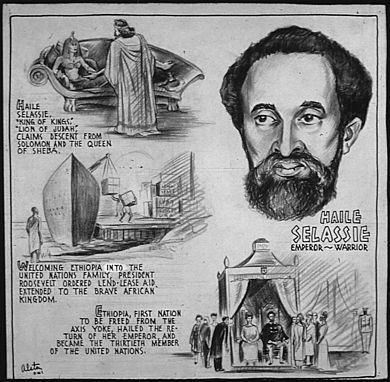
British forces, with help from Ethiopian fighters, worked to free Ethiopia. On 18 January 1941, Haile Selassie crossed back into Ethiopia. He joined the "Gideon Force" of Colonel Orde Wingate. Italy was defeated by forces from the United Kingdom, the Commonwealth of Nations, Free France, and Ethiopian patriots.
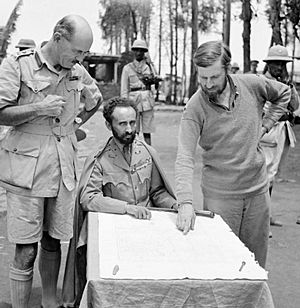
On 27 August 1942, Haile Selassie officially ended slavery in Ethiopia. He put in place strict punishments for slave trading. After World War II, Ethiopia became a founding member of the United Nations. In 1948, the Ogaden region was given to Ethiopia. On 2 December 1950, the UN decided to join Eritrea with Ethiopia. Eritrea was to have its own government, but Ethiopia would manage its money, defense, and foreign policy.
Haile Selassie tried to make changes, but he faced challenges. He tried to create a new tax system in 1942, but nobles opposed it. Ethiopia was still a "semi-feudal" country. The emperor's attempts to change the economy were met with resistance from the nobles and church leaders.
Between 1941 and 1959, Haile Selassie worked to make the Ethiopian Orthodox Tewahedo Church more independent. Before this, the church leader answered to the Pope of the Coptic Orthodox Church. In 1959, the Ethiopian Church became more independent but stayed connected to the Alexandrian Church. Haile Selassie also started taxing church lands.
In 1948, the Harari Muslims in Harar rebelled against the empire. The government responded with force. Many Hararis left the region.
Haile Selassie supported international peace. He sent Ethiopian troops, known as the Kagnew Battalion, to fight in the Korean War. They supported the United Nations Command.
In November 1955, Haile Selassie introduced a new constitution. He kept most of the power, but he allowed the lower house of parliament to be elected by the people. He also worked to spread modern education. Ethiopia began plans for development and modernization.
Haile Selassie tried to work with traditional leaders. He also tried to improve relations with different ethnic groups. He gave some independence to Afar lands. However, his reforms to end feudalism were slow. The 1955 Constitution was criticized for keeping the monarch's power strong and peasants weak.
Haile Selassie also had good relations with the United Kingdom. In 1947, he sent aid to Britain when it had heavy flooding. He also gave his exile home, Fairfield House, Bath, to the city of Bath in 1959.
Famine in the 1950s
In 1958, a famine happened in the Tigray province. Many people in Addis Ababa did not know about it. When reports of deaths reached the government in 1959, they asked for help. The Emperor donated grain, and the U.S. sent aid. But it is thought that about 100,000 people died before the famine ended in 1961. The famine was caused by drought, locusts, and diseases.
Challenges in the 1960s

In 1960, while Haile Selassie was visiting Brazil, his Imperial Guard tried to overthrow him. They briefly announced his eldest son, Asfa Wossen, as emperor. But the regular army and police stopped the coup. This event made many Ethiopians question the emperor's power. Students began to support the poor and peasants. This led Haile Selassie to speed up some reforms.
The emperor continued to be a strong friend of Western countries. He also strongly supported African countries becoming independent from European rule. The United Nations worked on Eritrea's future. In 1961, fighting began in the Eritrean War for Independence. Eritrea's parliament voted to become Ethiopia's fourteenth province in 1962. The war continued for 30 years.
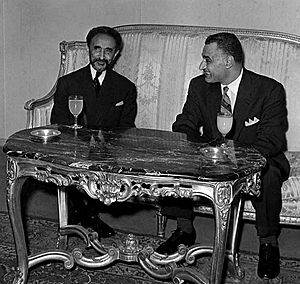
In 1963, Haile Selassie led the creation of the Organisation of African Unity (OAU). This group aimed to unite African countries. Its headquarters were in Addis Ababa. Haile Selassie was elected its first chairman. He also helped end a border conflict between Morocco and Algeria.
In 1963, the emperor attended the funeral of U.S. President John F. Kennedy. He was the only African head of state there. He also met with the new president, Lyndon B. Johnson.
In 1966, Haile Selassie tried to change the tax system. He wanted a single income tax that would hurt the nobility. This led to a revolt in Gojjam. The revolt was stopped, but the new tax was not fully put in place. This encouraged other landowners to resist the emperor.
Student protests became common in Ethiopia in the 1960s and 1970s. Many educated Ethiopians became interested in Communism. Haile Selassie's land reform ideas were hard to put into practice. This was because of resistance from nobles and the church. This made many peasants unhappy. As problems grew, Haile Selassie focused more on foreign affairs.
Later Years and Overthrow
Outside Ethiopia, Haile Selassie was still highly respected. As the longest-serving head of state, he was often given special honor at international events. He visited China in 1971 and met Mao Zedong.
Human rights in Ethiopia were not good under Haile Selassie's rule. There were few civil liberties or political rights. Some sources say political opponents were imprisoned. The Imperial Ethiopian Army also committed some terrible acts while fighting Eritrean separatists. An investigation into these acts began, but the government fell before it finished.
Famine in the 1970s
A severe famine happened in Wollo and Tigray provinces between 1972 and 1974. It is believed to have killed between 40,000 and 80,000 Ethiopians. Some reports say the emperor did not know how bad the famine was. Others say he knew. The famine and how it was shown in the media hurt the government's support. Haile Selassie's popularity dropped.
The crisis became worse due to military rebellions and high oil prices. The international economic crisis made the cost of imported goods and food very high.
The Revolution and Imprisonment
In February 1974, there were serious riots in Addis Ababa because of rising prices. The emperor tried to calm the public by lowering petrol prices. But the army was not happy with their pay. They rebelled, and the Prime Minister resigned. Haile Selassie agreed to more pay for the army. He named a new Prime Minister, Endelkachew Makonnen. But protests continued.
The Derg, a group of military officers, took advantage of the chaos. They removed the 82-year-old Haile Selassie from power on 12 September 1974. Haile Selassie was put under house arrest in the Grand Palace. Most of his family was also imprisoned.
On 23 November, 60 former high officials were killed without a trial. This included Haile Selassie's grandson, Iskinder Desta. These killings were known as "Black Saturday." The Derg then announced the end of the Solomonic dynasty.
Death and Burial
On 28 August 1975, state media said Haile Selassie died on 27 August from "respiratory failure." However, a doctor denied this. In 1994, an Ethiopian court found military officers guilty of killing the emperor in his bed in 1975. Documents later showed that the military regime ordered his assassination.
The government that followed the Derg fell in 1991. In 1992, Haile Selassie's remains were found under concrete. His coffin stayed in Bhata Church for almost ten years. On 5 November 2000, the Ethiopian Orthodox church held a funeral for him. But the government did not make it an official imperial funeral.
Some Rastafari leaders attended the funeral. However, most Rastafari did not accept the event. They did not believe the remains were Haile Selassie's. There is still debate among Rastafari about whether he truly died in 1975.
Haile Selassie's Family
Haile Selassie had six children with Menen Asfaw: Princess Tenagnework, Crown Prince Asfaw Wossen, Princess Zenebework, Princess Tsehai, Prince Makonnen, and Prince Sahle Selassie.
His children married into other noble families. For example, Prince Asfaw Wossen married Princess Wolete Israel Seyoum. Princess Tenagnework married Ras Desta Damtew.
Haile Selassie and the Rastafari Movement
Haile Selassie is seen as God in human form by some followers of the Rastafari movement. The movement's name comes from his earlier name, Ras Tafari Makonnen. The Rastafari movement started in Jamaica in the 1930s. Its followers believe Haile Selassie is the messiah who will lead people of African descent to freedom.
His official titles, like Conquering Lion of the Tribe of Judah and King of Kings of Ethiopia, are important to Rastafari. They see these titles as proof that he is the returned messiah mentioned in the Bible. The Rastafari faith in Haile Selassie's divinity began after news of his coronation reached Jamaica.
In 1961, the Jamaican government sent a group, including Rastafari leaders, to Ethiopia. They wanted to talk about people returning to Africa. Haile Selassie reportedly told the Rastafari, "Tell the Brethren to be not dismayed, I personally will give my assistance in the matter of repatriation."
Haile Selassie visited Jamaica on 21 April 1966. About one hundred thousand Rastafari came to greet him at the airport. The crowd was so large that he could not get off the plane. A Rasta leader, Ras Mortimer Planno, had to go onto the plane to calm the crowd. This day is now celebrated by Rastafari as Grounation Day.
After this visit, Jamaican officials made sure Rastafari leaders were at all events with the emperor. Rastafari elders also had a private meeting with him. He reportedly told them they should not move to Ethiopia until they had helped their own people in Jamaica. This idea became known as "liberation before repatriation."
Haile Selassie never told the Rastafari that their belief in him as God was wrong. He gave gold medallions to the faithful elders. Rita Marley, Bob Marley's wife, became Rastafari after seeing Haile Selassie in Jamaica. She said she saw a mark on his hand like the marks on Christ's hands. This helped her and others believe he was their messiah. She also influenced Bob Marley, who helped make Rastafari known worldwide.
Haile Selassie's Own View
In a 1967 interview, Haile Selassie denied being divine. He said, "I am only a man." However, many Rastafari do not see this as a denial of his divinity. Some believe he was being humble.
After returning to Ethiopia, he sent Archbishop Abuna Yesehaq Mandefro to the Caribbean. This was to help bring Rastafari and other West Indians to the Ethiopian church.
In 1948, Haile Selassie gave 500 hectares of land in Shashamane, Ethiopia. This land was for people of African descent who supported Ethiopia during the war. Many Rastafari families settled there and still live as a community.
Titles and Achievements
- 23 July 1892 – 1 November 1905: Lij Tafari Makonnen
- 1 November 1905 – 11 February 1917: Dejazmach Tafari Makonnen
- 11 February 1917 – 7 October 1928: Le'ul-Ras Tafari Makonnen
- 7 October 1928 – 2 November 1930: Negus Tafari Makonnen
- 2 November 1930 – 12 September 1974: His Imperial Majesty Haile Selassie I, King of Kings, Lord of Lords, Elect of God.
Military Ranks Held
Haile Selassie held high ranks in the military:
- Field Marshal, Imperial Ethiopian Army
- Admiral of the Fleet, Imperial Ethiopian Navy
- Marshal of the Imperial Ethiopian Air Force
- Honorary Field Marshal, British Army, 20 January 1965
Images for kids
See also
 In Spanish: Haile Selassie para niños
In Spanish: Haile Selassie para niños
- Black Lions
- List of people who have been considered deities
- List of unsolved deaths
- Bibliography of Haile Selassie


